



EU27 Livestock and Products Semi-Annual Report 2011
Lower feed prices in the first half of 2010 sparked piglet production and encouraged farmers to slaughter cattle and hogs at higher weights, according to the USDA Foreign Agricultural Service. As a result, the EU’s domestic supply of beef and pork rose significantly during the second half of 2010.Executive Summary
Cattle & Beef:
As a result of the recovery in milk prices during 2010, the contraction of the EU dairy herd slowed. There is also modest optimism in the beef cattle sector. EU producers hope to benefit from higher carcass prices and improved export opportunities for cattle and beef. However, the overall trend toward contraction of the herd is expected to continue and is mainly a result of increasing costs for land, feed and energy and diminished government support. In 2010, EU beef imports declined significantly due to slack EU demand and limited supplies from third countries. Due to slack domestic demand and increased domestic slaughter, EU beef supplies are thought to have temporarily outpaced demand. As beef prices in South America rose, Russia increasingly sourced from the EU. During the last three months of 2010, Turkey became an important growth market for EU beef exports as import tariffs were lowered. This year, EU exports are forecast to decline as domestic supply falls.
Swine & Pork:
In 2010, EU piglet production recovered as the sector benefitted from the lower feed prices, increased demand for pork in Russia and Asia, and a weak Euro. Following the increase in piglet production, EU slaughter increased during the second half of 2010 and is expected to remain high through the first half of this year. Elevated slaughter numbers and the dioxin crisis in Germany have led to a temporary oversupply, some of which will end up in export channels. During the second half of 2011, slaughter will fall because fewer piglets have been produced and fattened. Currently, many breeders and fatteners face negative margins due to the high feed prices. In addition, a large percentage of pig farms do not yet comply with the EU environmental and animal welfare requirements entering into force in 2013. A number of farmers are expected to exit the business. Under a scenario of continuing high feed prices, the pork supply will fall and will in resulted in reduced exports in 2011.
Commodities:
Animal Numbers, Cattle
Cattle
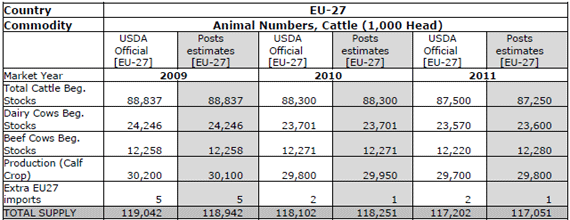

Recovering milk and beef prices slow contraction of dairy herd.
As a result of the recovery in milk prices during 2010 (see graph below), the rate of contraction in the dairy herd has slowed, and the 2011 beginning dairy cow stocks figure has been adjusted upwards slightly. For the same reason, 2011 cow slaughter is reduced from the previous forecast. Cuts in the dairy cow herd are reported in France (-1.4%) and in the New Member States (NMS) in particular in Hungary (-0.1%) and Romania (-2.7%). In other EU Member States the size of the dairy cow herd was relatively stable in 2010.
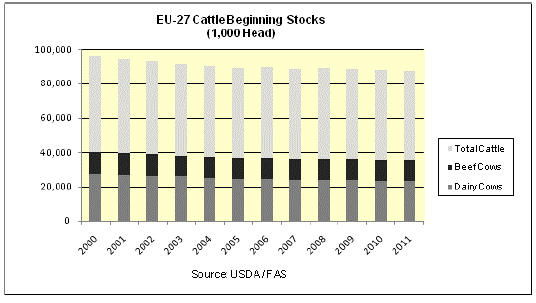
Modest optimism in the EU beef cattle sector.
The EU beef cow herd recovered in 2010. Significant increases in the beef cow herd are reported in Poland (7.5%), Spain (2.4%) and the UK (2.0%). Farmers hope to benefit from the increased carcass prices (see graph below) and increased opportunities for the export of cattle and beef (See Beef section) to third countries. EU exports of cattle to Northern Africa and the Middle East increased significantly as a result of reduced competition from Brazil and Australia in these markets. In 2011, EU cattle exports are forecast to decline mainly due to lower French exports to Lebanon due to stricter Bluetongue Disease vaccination requirements, and to Algeria due to the closure of import quotas. The recent political instability in Northern Africa and the Middle East is also expected to have a negative effect on cattle exports to these regions. Reductions in the beef cow herd were reported in mainly Ireland (-4.7%) and Germany (-3.0%). An increase in the number of live cattle exported by Ireland in 2010, principally to the UK, and an in tandem increase in slaughter volumes, will limit the availability of finished cattle in 2011.
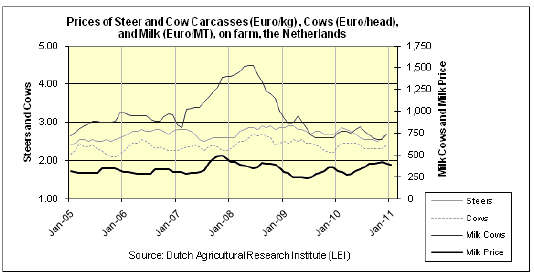
Contraction of the cattle herd is expected to continue.
As a result of the improved outlook for dairy and beef cattle, calf production forecasts for 2010 and 2011 have been adjusted upwards. However, the downward trend in calf production is expected to continue in 2011. This is mainly a result of increasing costs for land, feed (see graph below) and energy, and less generous government support. During the past five years, per head subsidies and slaughter premiums and dairy product price support schemes were phased out. However, improved per cow production within the dairy quotas system has contributed to a contraction of the dairy herd. Throughout the EU, the smaller farms with only a few cows are abandoning the sector, while the biggest and most efficient farms are expanding. After a reduction of 2.4 percent in 2009, the calving is expected to decline 0.5 percent in 2010 and 0.5 percent in 2011. The EU cattle stock is projected to shrink 2.5 percent during 2009 – 2011, from 88.8 million head to 86.8 million head.
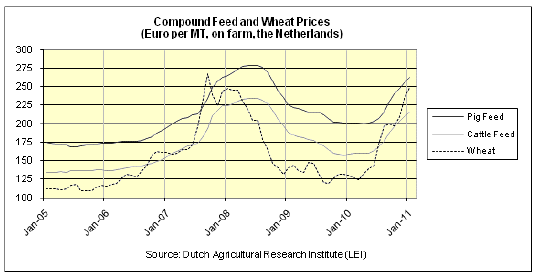
Animal Disease Situation
-On January 4, the Bulgarian Ministry of Agriculture and Food reported a case of Foot and Mouth Disease (FMD) in Southeastern Bulgaria, near the Turkish border. The EU reference laboratory determined the FMD virus strain found as typical of Iran and the Asian part of Turkey. The local veterinary office was reportedly able to confine the outbreak. Only the Ukraine and Moldova, which are not major Bulgarian livestock/meat trade partners, banned imports from the country (see GAIN Report published on 1/14/2011).
Commodities:
Meat, Beef and Veal
Beef

Limited world supply, slack demand and a weak Euro restrict imports
Final 2010 EU beef imports are now expected to have declined by 59,000 MT to 436,000 MT (see graphs below). In our Annual Report, imports were forecast to decline by only 7,000 MT. In 2010, imports from the United States grew, while imports from Brazil declined slightly. Marketing efforts by U.S. suppliers and interest from EU importers for the new quota for high quality beef are growing (see Policy section). However, the supply of beef from South America, North America, and Oceania remained limited. During 2010, beef prices in South America almost reached domestic price levels in the EU. Imports from Argentina plummeted due to cattle shortages and export restrictions imposed by the Argentine government. Besides the limited supply, other factors of importance are the weak Euro, and weaker EU demand. Higher beef prices, in combination with the economic recession, lowered EU beef sales. Another factor behind stagnating beef consumption is the increasing popularity of broiler meat due to its lower price, perceived health advantages (lower fat) and convenience (see graph below). A significant import recovery in 2011 is only possible if the supply side of the market changes, such as a drastic reduction of domestic demand in South America, a significant change of the Euro exchange rate with the South American currencies, or a change in the Argentinean export policy. In 2011, EU beef imports are expected to rise slightly to 450,000 MT mainly due to increased imports from the U.S., filling the quota for high quality beef.
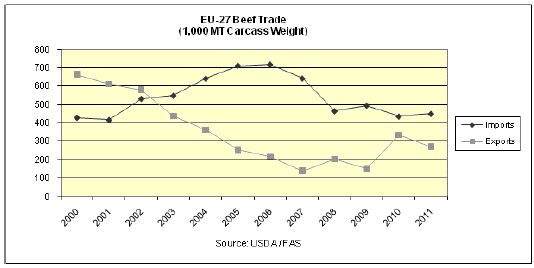
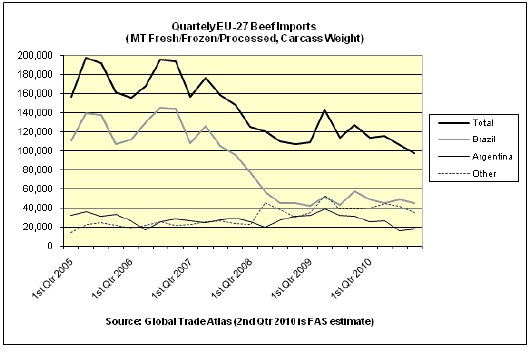
Elevated domestic supply and increased world demand drove exports.
The average slaughter weight increased more significantly than was anticipated in our Annual Livestock Report. Animals were slaughtered at a higher weight due to lower feed price levels, higher carcass prices, and increased slaughter of beef cattle relative to dairy cattle. As consumption slackened, the EU beef supply is thought to have temporarily outpaced demand. This resulted in private stock building and increased availability for exports. As beef prices in South America rose, Russia increasingly sourced from the EU. Exports were further supported by a weak Euro against the Brazilian Real and the Russian Ruble. During the last three months of 2010, Turkey became an important growth market for EU beef exports as import tariffs were lowered. Most Turkish imports were sourced from Germany and Poland. The increased exports to Russia and Turkey benefitted the sector by pushing up prices for cattle and beef throughout Europe. In 2011, Russia will reportedly retain current quota volumes for frozen and fresh beef, 530,000 MT and 30,000 MT respectively. Despite the good outlook for exports to Russia, and the new opportunities in Turkey, EU exports are expected to decline in 2011. This forecast is based on falling EU beef supply during 2011.

Update on the new EU beef import quota for high quality beef
During 2006 – 2008, annual U.S. beef exports to the EU increased from 500 MT to 5,100 MT, mainly due to increased efforts of importers and wholesalers. In 2009 and 2010, U.S. beef imports were further supported by the introduction of the new zero duty quota for high quality beef (HQB). In the first quota year, which covered eleven months from August 2009 through June 2010, 8,972 MT out of the 20,000 MT of available quota volume was used. This success is continuing in the second quota year. For the first seven months of the 2010/2011 quota year, import license applications for the HQB quota have been filed for all the available volume, namely; 13,333 MT. In CY2009, U.S. beef exports to the EU rose to 7,500 MT and increased further in CY2010 to 11,700 MT, with an estimated value of 110 million USD.
On November 23, 2010, the publication of Commission Communication 2010/C 318/02 [1] in the EU authorized the inclusion of Canadian been under the HQB quota. (The United States and Australia are the only other countries that enjoy HQB quota access.) Furthermore, Canada has finalized its own hormone case settlement agreement with the EU, but the agreement must still be endorsed by EU Member States and Canada. Expectations are that Canada, like Australia, will need considerable time to establish beef production meeting the criteria for this quota.
Background
The details for the administration of this zero duty, 20,000 MT beef quota were published in Commission Regulation (EC) No 620/2009 [2] . This U.S. - EU compromise deal was formally approved in Council Regulation (EC) No 617/2009 [3] , published in the Official Journal on July 15, 2009. The quota was put into place on August 1, 2009, for a period of two years. With mutual agreement, the quota will be enlarged to 45,000 MT after this period. Go for more information to the website of the U.S. Mission to the EU.
Commodities:
Animal Numbers, Swine
Swine
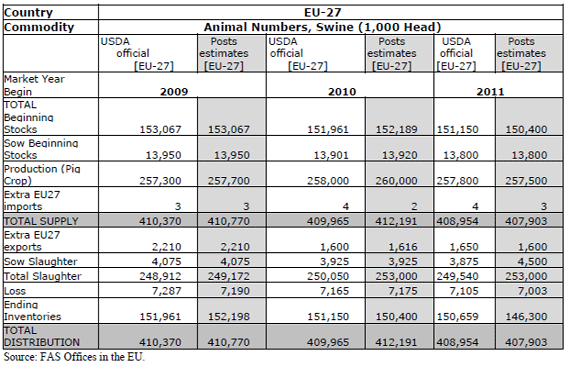
Piglet production recovered temporarily in 2010.
As anticipated in our Annual Livestock Report, EU piglet production recovered in 2010 (see graph below). The upturn took place mainly in Denmark, the Netherlands, the UK and Poland. The Danish and Dutch sector benefitted from lower feed prices, increased demand for pork in Russia and Asia, and a weak Euro. In the UK, the low Sterling/Euro exchange rate increased profitability, and farmers responded by increasing sow stocks and piglet production. In Poland, the cutbacks in piglet production in 2008 and 2009 were followed by a recovery of 1.6 percent in 2010. This rebound is supported by better market conditions, lower feed prices, and higher prices for piglets and hogs. Following the increased piglet production, EU slaughter increased during the second half of 2010. Another factor for the elevated slaughter is the reduction of the trade of slaughter hogs to Russia.
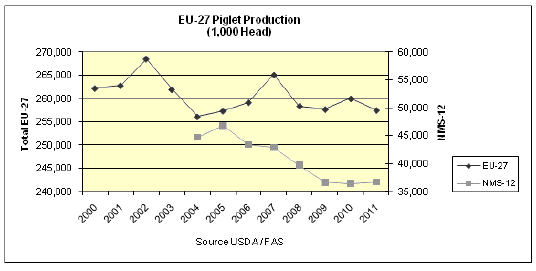
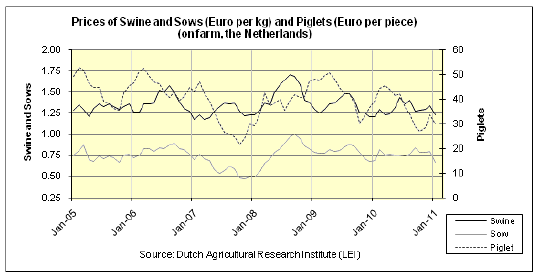
Hog restructuring accelerated by high feed prices and the dioxin crisis.
A large percentage of pig farms do not yet comply with EU environmental and animal welfare requirements entering into force in 2013 (see Policy section). As margins have been tight since 2007, farmers are reluctant to invest in their farms, and a significant number of farmers are expected to exit the business. This restructuring implies an end to the most inefficient commercial farms throughout the EU and a reduction in backyard farming, in mainly the New Member States (NMS). High feed prices and the fall in slaughter hog prices caused by the recent dioxin crisis in Germany have accelerated this process. In February, carcass prices recovered but remain under the level on which most fatteners in Northwestern Europe could achieve positive margins. As a consequence, the 2011 pig crop forecast is lowered, and the 2011 total and sow slaughter numbers increased over earlier forecasts. Total swine ending stocks for 2011 are lowered accordingly. The negative fattening margins are expected to force farmers to slaughter their animals earlier and at a lower weight. As a consequence slaughter will peak during the first half of 2011. During the second half of 2011, slaughter will fall significantly due to a reduction in the number of animals.
The most significant production cuts are expected in Denmark, Spain, France and the Benelux countries. Although the Danish pig industry is well prepared for the implementation of new EU regulations in 2013, the profitability of the Danish swine sector will be lower during the first months of 2011. Feed costs have increased, while piglet and carcass prices fell more than expected due to the oversupply situation in the EU and the dioxin crisis in Germany. In Belgium and the Netherlands the situation is similar. Also, the Spanish hog sector is facing negative margins as a result of increased production costs and falling carcass prices. French pig producers blame higher feed costs as well as competition from Germany (due to lower labor costs – German slaughters tend to use more immigrant labor) for their decreased production. French producers recently launched an unfair competition complaint against Germany at the EU level.
Piglet production and slaughter is expected to increase in Germany, the UK and Poland. In Germany, the industry hopes that the low prices will soon encourage domestic consumption and exports once the dioxin topic moves out of the media. Increased slaughter will mainly be driven by increased imports of piglets and slaughter hogs from Denmark and the Netherlands. In the UK, the size of the pig herd is expected to further expand, driven by increased breeding efficiency and disease control. The total EU pig herd is forecast to decrease during 2009, 2010 and 2011, respectively by 0.6, 1.2 and 2.7 percent.
Sustainability and Animal Welfare
Housing Requirements for Swine
By January 1, 2013, the EU swine sector will need to comply with additional environmental (Council Directive 2008/1/EC) and animal welfare regulations (Council Directive 2001/88/EC). Council Directive 2008/1/EC sets limits on the ammonia emissions from livestock farms and in many cases will require adjustments in animal husbandry and/or investments in air treatment systems. Council Directive 2001/88/EC imposes specific requirements for the housing of pigs related to animal welfare such as introduction of group housing for sows, and the expansion of the living area for weaned piglets and fattening pigs. A large percentage of pig farms do not yet comply with the EU environmental and animal welfare requirements that will enter into force in 2013. As margins have been tight since 2007, farmers are reluctant to invest in their farms and a significant percentage are expected to exit the business. For instance, a study of the Dutch Agricultural Research Center (LEI) did not give exact figures about the impact on the Dutch pork industry but concluded that a double digit percentage decline in pig numbers is possible before 2013.
Industry initiative for banning pig castration by 2018
On December 16, 2010, the EU pork sector announced an industry initiative to end the surgical castration of pigs, on animal welfare grounds. At the instigation of the EC, various organizations across the entire EU pork industry chain signed a European Declaration on alternatives to surgical castration of pigs [1] . The EU farmers union, Copa-Cogeca and EU associations for meat, veterinary, animal breeding and animal welfare all pledged to collaborate on finding alternatives to castration of pigs. They further pledged to stop all castration of pigs without the use of anesthesia as of January 1, 2012 and work to have a total ban of the practice by 2018. The EC launched an on-line initiative for endorsing the declaration. [2] This initiative was triggered by concerns that many different initiatives by various retailers and Member States were threatening to break up and divide the EU pork market, leaving the major pork processors with huge logistical problems and costs to handle many different schemes.
The EU pig crisis
At a presentation on the difficulties facing pork producers at European Parliament’s Agricultural Committee on February 7, 2011, DGAgri concluded that the EU was “shooting itself in the foot.” The pig crisis was reportedly the result of high production costs, as a consequence of EU policies on biotech (GMO) crops and feeds, and not the result of low pork prices. Many of the current difficulties in the EU pork sector were in fact forecast in a 2007 Commission report titled, "Economic Impact of Unapproved GMOs on EU Feed Imports and Livestock Production [3] ." The EC has formed a special expert committee to study the situation in swine sector and they are expected to finalize recommendations in April.
Animal Disease Situation
Romanian exports of live animals and pork to EU Member States have been prohibited since 2003, when the first outbreaks of Classical Swine Fever (CSF) were reported. In December 2010, Romania received a response from the EC regarding a change in their official disease. In order to resume pork exports, the solution proposed by the EC was to create compartments at the county level for both production and processing. Only those farms/processing plants which are under the strict control of veterinary authorities will be allowed to export pork and other meats to EU Member States.
Commodities:
Meat, Swine
Pork
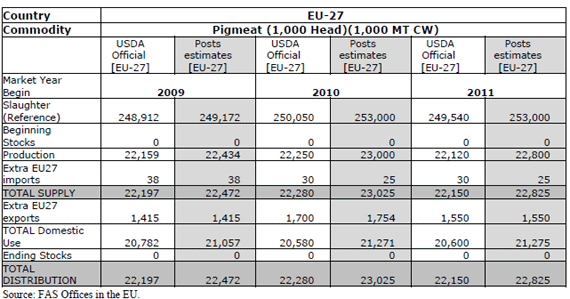
Exports recovered temporarily in 2010.
In line with elevated slaughter and a higher slaughter weight than anticipated, 2009, 2010 and 2011 pork production forecasts are adjusted upwards. Domestic consumption is accordingly adjusted higher. In the previous Semi-Annual Report, a recovery in trade was anticipated for 2010. In the Annual and in this report, the 2010 export volume is revised further upwards. Pork exporters benefitted from the economic growth, and thus demand for pork, in Russia and Asia, the low supply from the U.S. and Brazil, and the low value of the Euro and Kroner against the currency of both competitors as well as of customers. Another factor is the reduction of the trade in EU slaughter hogs to Russia which lowered Russian slaughter and pork production. According to industry sources, the limited number of plants still blocked by Russian authorities had no effect on the export capacity of the EU. For the year 2011, the Russian quotas are set at the same level as in 2010; 472,100 MT for fresh and frozen pork plus 27,900 MT for trimmed pork meat. The EU part of the quota is 225,000 MT.
Dioxin crisis drives temporary oversupply.
During the first two months of 2011, commercial stocks are expected to increase as a result of the dioxin crisis in Germany. The dioxin scandal reduced German pork consumption temporary by ten percent, and led to short-term closure of some export markets. Of these, only Belarus remains closed. Some other countries, like Russia and South Korea, still require additional documents, dioxin testing, or may impose additional requirements on case by case basis. On February 1, the EC also opened a PSA program (Private Storage Aid, see Policy section) to support pork producers. The commercial and PSA stocks will increase mainly in Germany and neighboring countries; Denmark, the Netherlands and Belgium. The current PSA stocks are estimated at about 150,000 MT, and are not expected to expand further as carcass prices rose above the level which is requisite for the PSA. It is anticipated that a part of this temporal oversupply will be made available for exports. South Korea is a potential growth market as a result of the FMD outbreaks in this country. Producers and traders will certainly try to benefit from the South Korean tariff-free quota of 60,000 MT to be imported between January and the end of June. The EC is not planning to grant export restitutions but the price fall of pork EU-wide points to increased competitiveness. Depending on the availability of import licenses granted, pork exports to Russia are also expected to increase during the first two months of 2011.
Lower supply are expected to press exports.
Overall, EU domestic supply in 2011 is expected to decline as hog fattening operations will slaughter animals at a lower weight. During the second half of 2011, pork production will fall, as slaughter accelerates and thus peaked during the first half of the year. However, if during the second half of 2011, feed prices decline, hogs will be slaughtered at a higher weight, and pork production could be maintained or even increase. The forecast in this report is based on feed prices similar to current levels. According this scenario, the lower domestic supply of pork will reduce exports in 2011. Taken over the whole year, EU pork exports are forecast to drop from 1.75 MMT in 2010 to 1.55 MMT in 2011. Due to the limited domestic supply, and associated price recovery, EU domestic use of pork is forecast to stagnate.
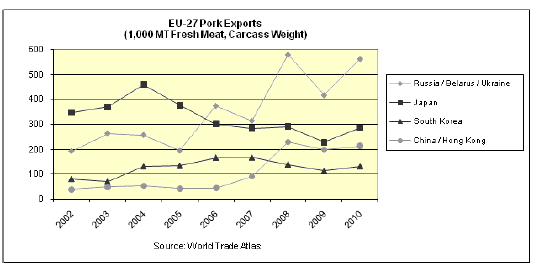
The dioxin crisis in Germany and measures of the EC
In response to the dioxin crisis in Germany (see internal GAIN Reports GM1002 and GM1003), the EC opened a Private Storage Aid (PSA) program on February 1, 2011. The text of the PSA is:
http://eur-lex.europa.eu/LexUriServ/LexUriServ.do?uri=OJ:L:2011:026:0002:0004:EN:PDF
Under this program, contracts for pork storage can be taken for 90, 120 or 150 days. Pork that is stored under these contracts is meant to be exported to third countries out of concern that it would otherwise overload the domestic market later this year. No quantity limit has been set for the program, but because of the requirement that only pork below 103% of the EU reference price is eligible, it is likely increasing prices will forestall further storage contracting. On February 23, the EC terminated the program. It is estimated that about 150,000 MT of pork has been taken out of the market.
Further Reading
| - | You can view the full report by clicking here. |
March 2011


